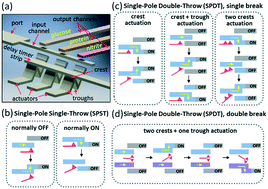A fast, reconfigurable flow switch for paper microfluidics based on selective wetting of folded paper actuator strips†
Abstract
In paper microfluidics, the development of smart and versatile switches is critical for the regulation of fluid flow across multiple channels. Past approaches in creating switches are limited by long response times, large actuation fluid volumes, and use of external control circuitry. We seek to mitigate these difficulties through the development of a unique actuator device made entirely out of chromatography paper and incorporated with folds. Selective wetting of the fold with an actuation fluid, either at the crest or trough, serves to raise or lower the actuator's tip and thus engage or break the fluidic contact between channels. Here the actuator's response time is dramatically reduced (within two seconds from wetting) and a very small volume of actuation fluid is consumed (four microliters). Using this actuation principle, we implement six switch configurations which can be grouped as single-pole single-throw (normally OFF and normally ON) and single-pole double-throw (with single and double break). By employing six actuators in parallel, an autonomous colorimetric assay is built to detect the presence of three analytes − glucose, protein, and nitrite − in artificial saliva. Finally, this work brings the concept of origami to paper microfluidics where multiple-fold geometries can be exploited for programmable switching of fluidic connections.



 Please wait while we load your content...
Please wait while we load your content...